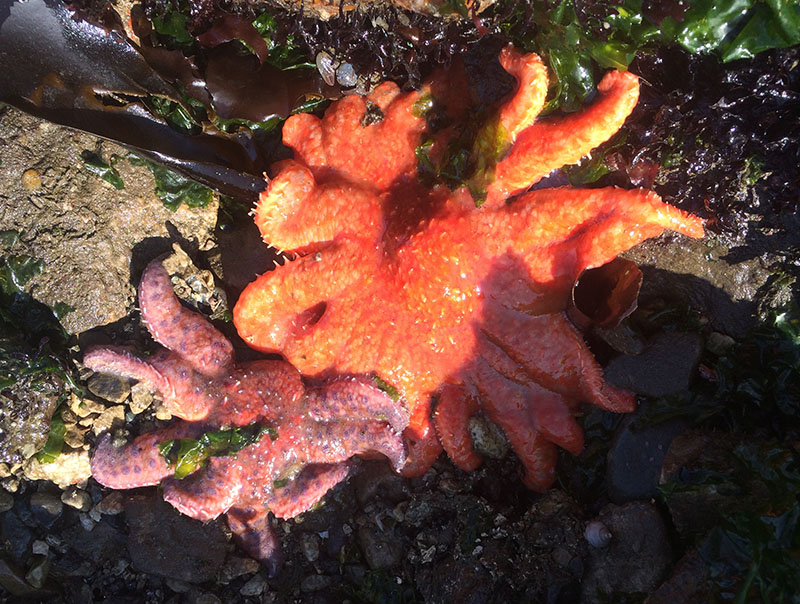Jason Hodin is a Senior Research Scientist at Friday Harbor Labs. You can donate to his sunflower star captive rearing effort at the UW Giving campaign Stars for the Sea.
Among the world's hundreds of types of known starfish (or seastars as I'll call them), our Pacific coast sunflower stars are true record breakers. They are the largest seastar in the world, with an arm-tip-to-arm-tip "wingspan" of more than two feet when fully grown. Using their thousands of tube feet, sunflower stars can glide a hundred-yard dash in under an hour; certainly bronze medal speed at least! They're well known to ocean lovers for their brilliant colors, and to marine biologists for the fear they invoke in their many types of prey. Contact with a sunflower star will cause seafloor species – such as scallops and sea cucumbers – to defy their reputation as sedentary creatures and swim, in a desperate attempt to escape the clutches of the star's 21+ arms.

Recently, sunflower stars
(Pycnopodia helianthoides) broke another record, but one less worthy of celebration: of the dozens of west coast seastar species impacted by a mysterious
syndrome known as seastar wasting disease, sunflower stars were hit the hardest. Starting about 8 years ago, sunflower star populations up and down the coast started to plummet, with the syndrome turning these majestic beasts into piles of goo. They have now all but disappeared from the southern part of their former range, and their numbers in our area and further north are drastically reduced. This calamity led the International Union for the Conservation of Nature to include the species in its latest "red list" of endangered species, the
first such listing for any seastar.
Photo: Sunflower stars found by Richard Emlet in the intertidal on San Juan Island, July 2019. The smaller one (about 5 inch diameter) was below our target size for collecting; the larger orange one is in our colony and is named Níspero, the Spanish word for Loquat. Credit: J. Hodin.
Like wolves and sharks, sunflower stars are top tier predators and over the past 50 years, scientists have come to realize just how important such predators are to thriving ecosystems. In the mid 1960s,
University of Washington zoology professor Bob Paine first identified predatory seastars as the so-called "keystone species" in certain seafloor habitats: remove the keystone and the stable structure of the ecosystem falls apart. With the recent disappearance of sunflower stars in Northern California, we have seen this process play out in shockingly dramatic fashion. Coincident with the seastar declines, populations of one of their favored prey – the purple sea urchin – have exploded, and the unchecked urchins have in turn,
clearcut the once mighty forests of coastal kelp, already stressed from warming waters. At latest count, kelp in that region has been reduced to a mere 5-10 percent of its former numbers. Kelp forests are well named: they are truly the rain forests of the ocean, providing crucial habitat for countless species of algae, fish and invertebrates, buffering the coasts from storms and mitigating climate change. Current conditions are dire.